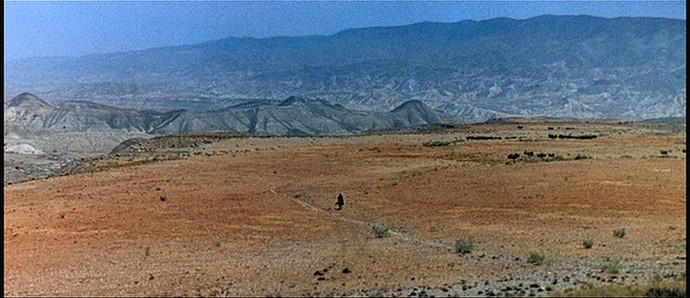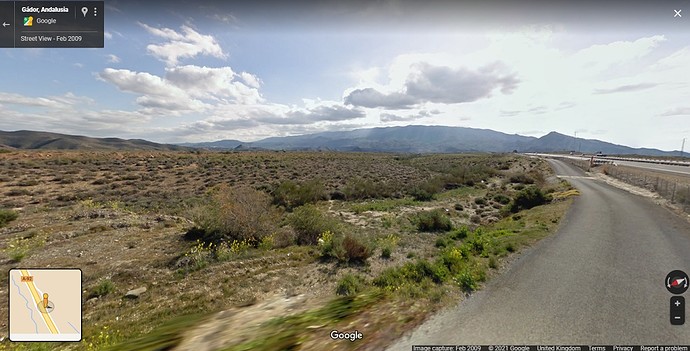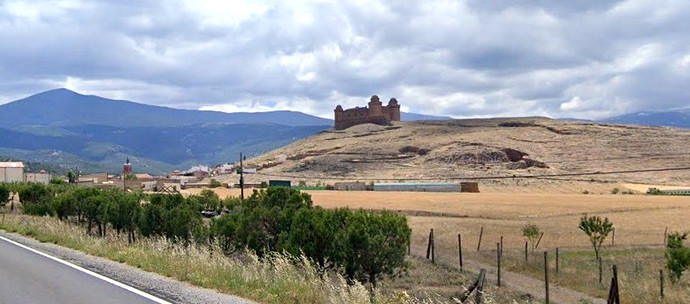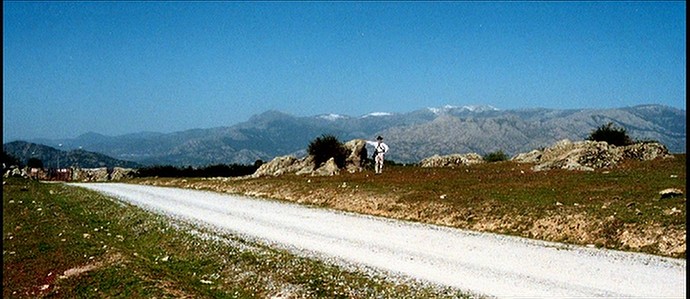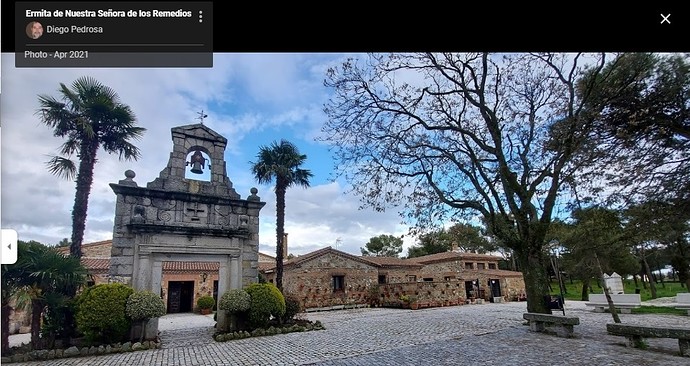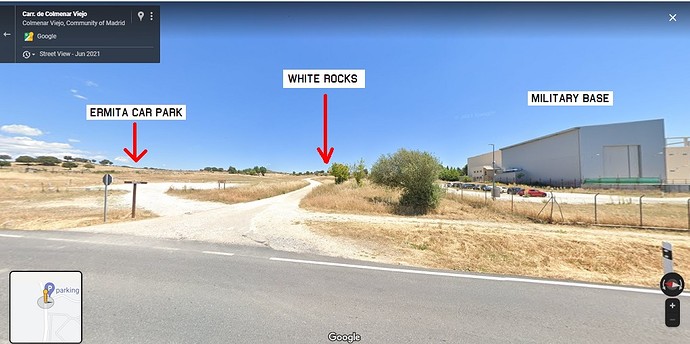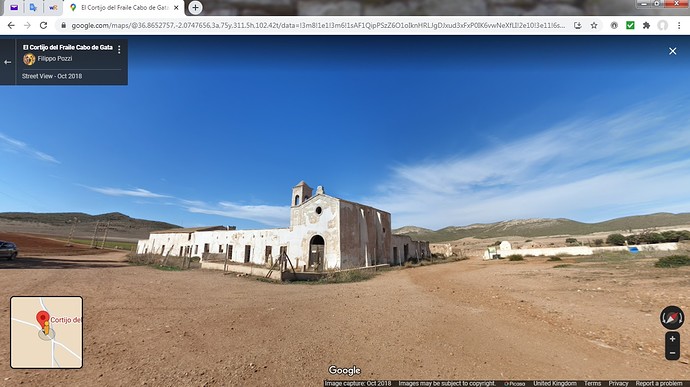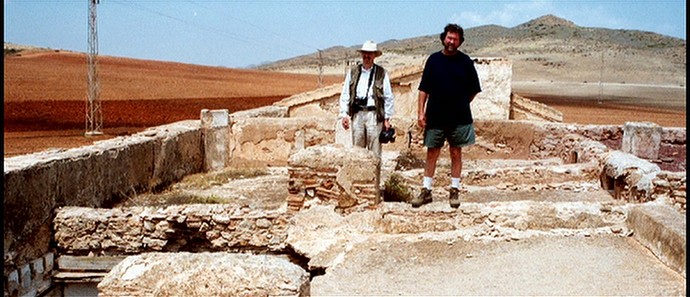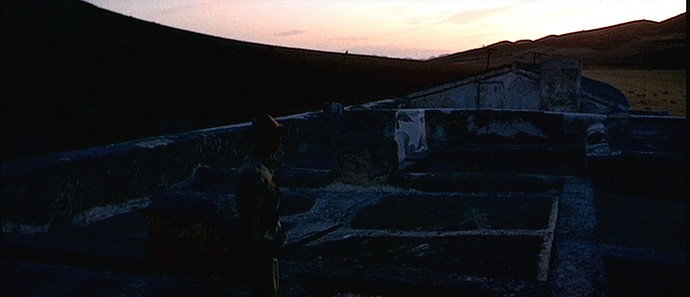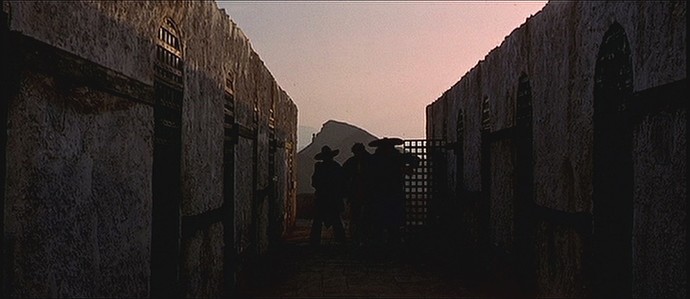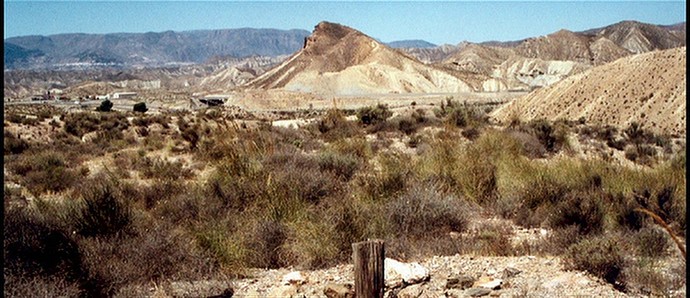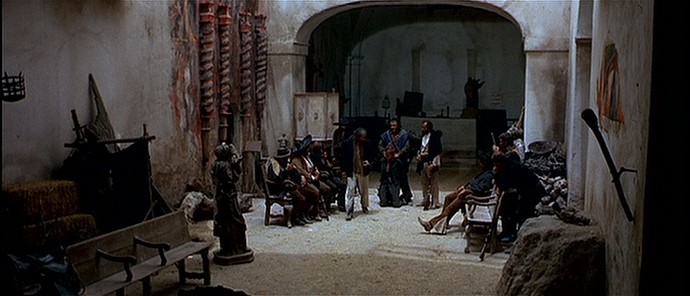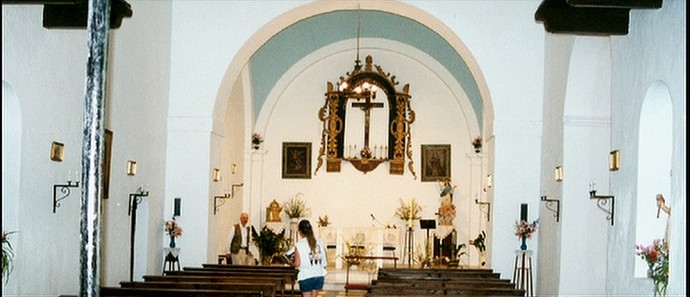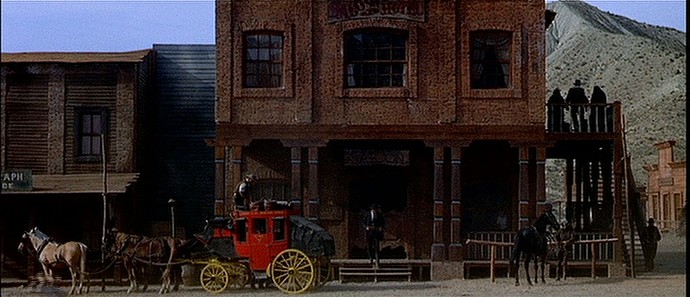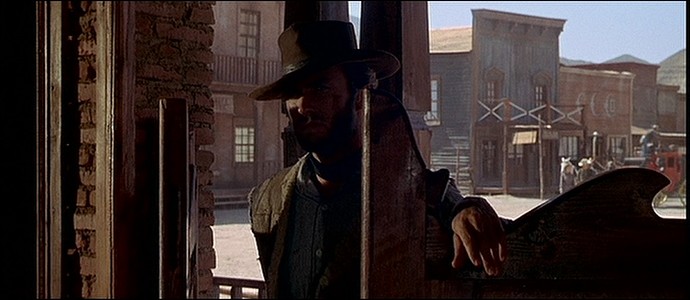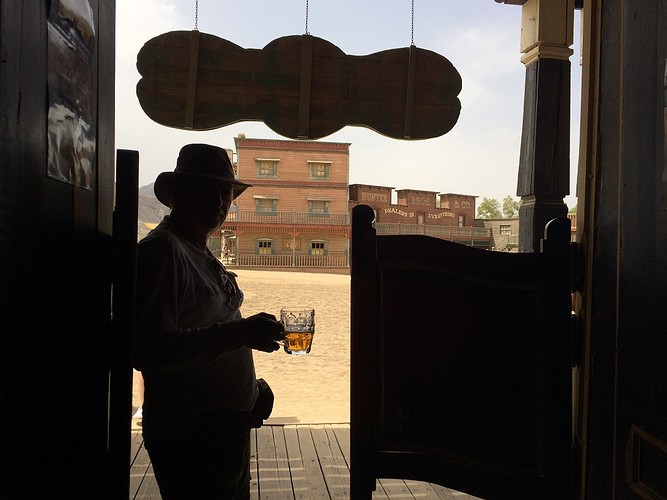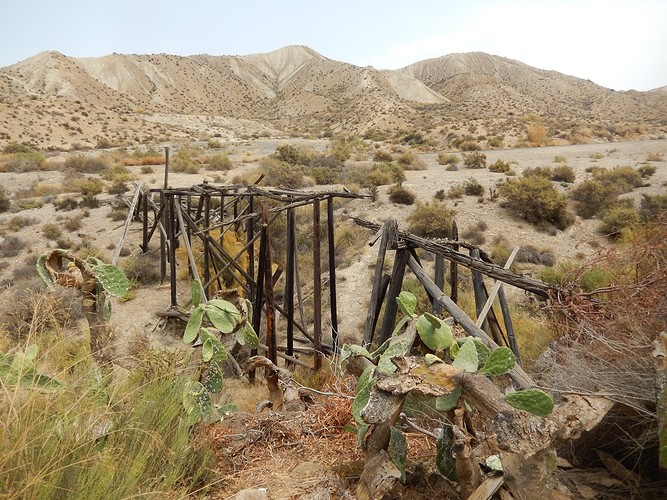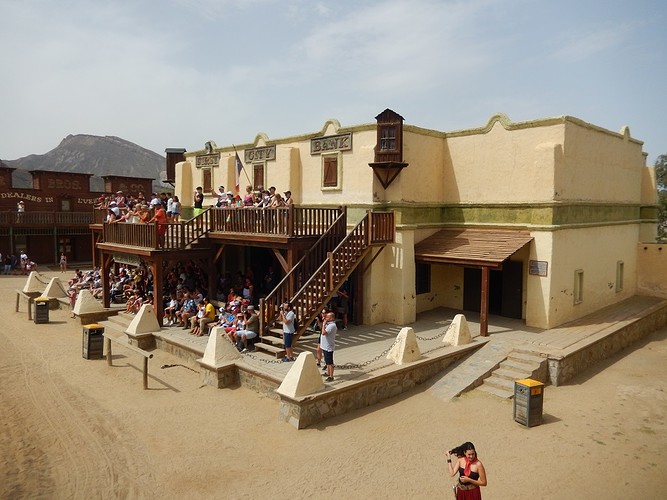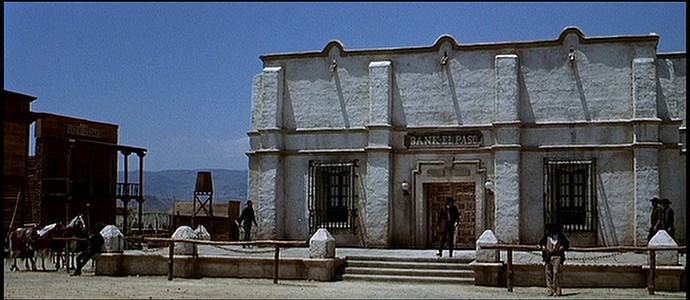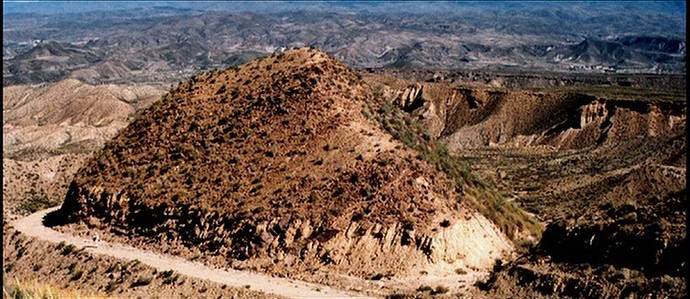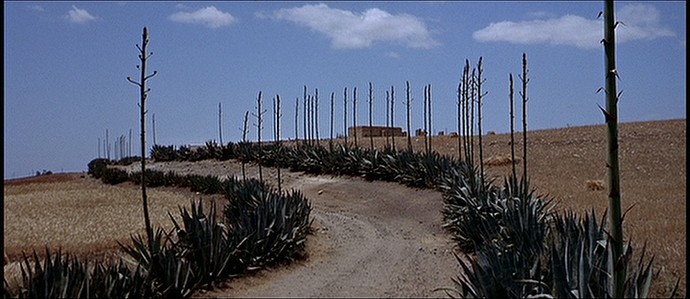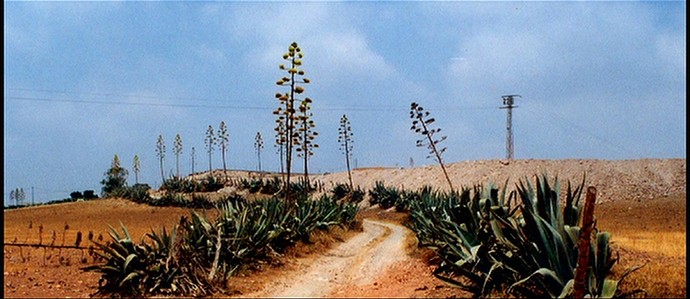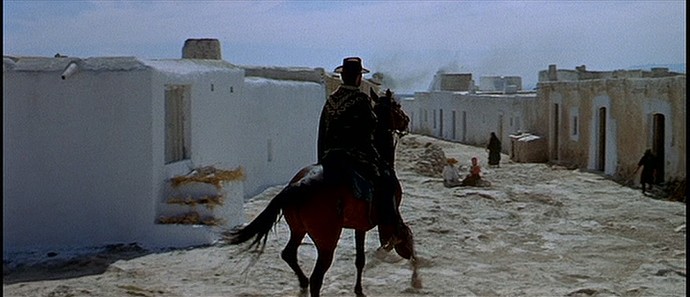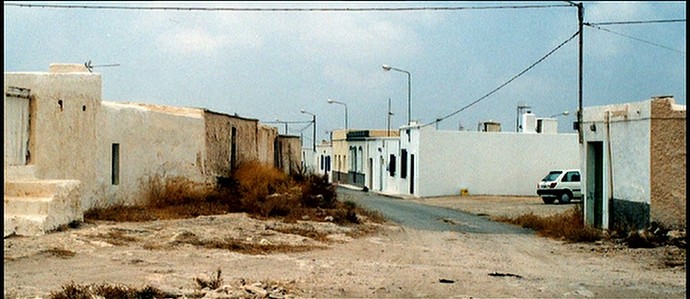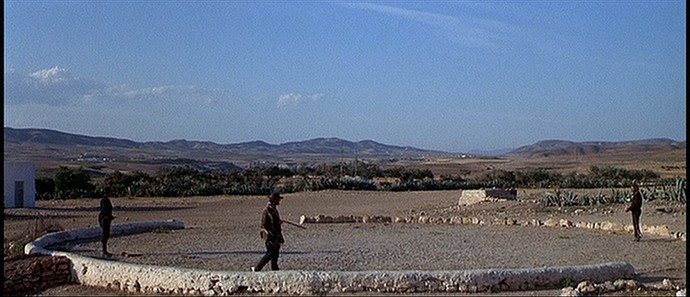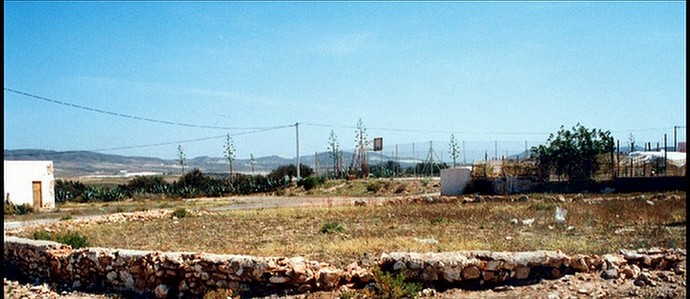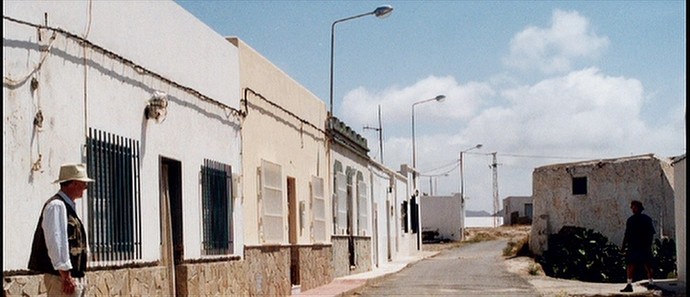- Riding away with the safe - the road past Castillo De La Bateria, Rodalquilar
(Warning, this story may upset people of a nervous disposition)
Rule Number Six: “Never drive into soft sand!”
It was the moment when Don looked one way and saw Castillo De La Bateria, and I looked the other and saw those famous rocks. And we figured that to get his camera angle, Leone would’ve had to move off the road some way. So we turned round and spotted this little dirt track right next to the Castillo, and deciding that this was where we should go, Don reversed the car and began to drive along there. We didn’t get very far forward because the track curved around and then abruptly vanished into a clump of brushwood. And now we suddenly couldn’t get back, because the front wheels were up to the hub-caps in soft sand.
Don gunned the engine, and tried to get a purchase with the wheels, but it was a front wheel drive, and they were just digging themselves deeper.
It was one of those Laurel and Hardy moments - we sort of looked at each other, rolled our eyes, and went “uh oh!”
Well, looking back, it seems quite amusing now, but you have to know that this was the second time in our Spanish trip that Don got the car stuck. And he still hadn’t quite learned the lessons.
We started to do all the futile stuff again; jacking up the chassis so we could shove stones and branches under the front wheels; me trying to push, while Don tried to reverse. We even found a complete door that had been discarded in the gulley next to us, probably by the last suckers who got stuck here, and we jammed that under the drive-wheel. But nothing was working, and that was no big surprise to me. Then Don spotted a car heading back to Rodalquilar from the beach, and I dashed to the road and flagged it down.
“Lo Siento, Senor. Necessito un Telefono por El Coche. Vamonos a Rodalquilar?”
It was a young man and his wife, and I think I’d told them that I needed a Telephone on account of the car, and could we go to Rodalquilar where I knew there was a tourist information office.
They opened the back door and re-arranged the sun-loungers that were piled on the backseat to give me some room, and then motioned me to get in. I turned and yelled to Don: “I may be some time!” And then we were speeding up the dusty road towards Rodalquilar, and hopefully a telephone.
I tried to converse with them, explaining that the car wheels were stuck in the sand, and the man, realising that Spanish was not my native tongue, started to slowly but carefully speak to me in English. He’d obviously been afraid to use the language at first, because he probably was a little unsure of himself, but he actually spoke very well, and it was far better than my concocted Italo-Spanish.
He said that I was very lucky to have spotted them, since they were the last people on the beach. It was mid-afternoon, and they’d finally decided to leave because their car was getting so hot where it was parked, that they were worried the engine would overheat and refuse to start.
A short way along the road we passed a field in which there was a lorry being filled with dirt by a tractor. The wind was very strong by now and the dust was blowing everywhere, with great clouds of the stuff billowing across the road like a veritable sandstorm.
Did I say “Tractor”?
The thought suddenly hit me - what we needed was a tractor to pull us out of the sand, and there was one right here.
I got the gentleman to stop his car, then leapt out and started running across the field to ask if these guys could help. I waved to the tractor driver to stop, and was about to tell him my problem, when the car driver comes running up behind me and takes over in Spanish. There’s a lot of gabbling going on, and the driver of the lorry is here too now, and finally there appears to be some sort of positive agreement, so the car driver turns to me and says:
“He’s just got to finish filling the lorry - about ten minutes, then he’ll get your car.”
That was great news! I thanked the driver profusely, and watched him walk away across the dusty field towards his car, and then with a final wave, this Knight of the road was off towards Rodalquilar, trailing a plume of dust behind him.
Whilst I was waiting for the lorry to be filled, the driver came across and started chatting to me. He asked if I was German, because he said that he knew a little of that language having spent some time working over there. I think he must have mistakenly detected a trace of Germanic accent in my pronuciation of Spanish - and here’s me thinking I sound just like Rod Steiger in DUCK YOU SUCKER.
I explained that I was English, and had an American friend back at the car. So we elected to continue our conversation in Spanish.
Then he asked if I had a rope with which to haul out the car.
“A rope? Isn’t there one with the tractor?”
There wasn’t. But on the back of the lorry amongst all the debris and rubbish being piled in amongst the soil, there was what looked like some twisted steel cable. “How about that?” I asked.
The lorry driver nodded and strolled back to his vehicle to try and haul the cable from out of the the rest of the rubbish. But the other end was obviously lodged deep under the load and wouldn’t budge. So he waved the tractor over, and attaching the free end to the jaws of the fork, he got the driver to back off and haul it out. There was a moment or two where it looked like it wasn’t going to budge; where the force of the tractor was shaking the lorry on it’s suspension, and threatening to haul it’s wheels into the air, but eventually the cable came free.
Well, now we were set, so I sat back, lit a Toscana and waited. I couldn’t help thinking of Don back there at the car, all on his own, gazing at the lonely road whilst the blustery wind blew clouds of sand across the dark mountains as the sun slowly cast it’s evening shadows; and him sat there wondering when I was going to get back. And then I remembered that bit in ONE-EYED JACKS, where Karl Malden goes to find some horses, and leaves Marlon Brando sat atop a wind-strewn hillside surrounded by Rurales. Malden gets the horses, and rides on, and Brando gets caught by the Rurales and ends up in jail.
Heck, I couldn’t leave a friend in trouble - I’m British, for God’s sake.
Half way through the Toscana, trouble arises. This little guy with a flat cap comes marching across the field to find out what’s going on. He’s apparently the site manager, and he’s in charge of getting the field cleared so they can build a new hotel. He sort of reminded me of Louis De Funes: overly officious, a real know-it-all, and with that same kind of rubbery face.
“That cable is no good” he tells me. “It’ll break!”
“No, it’ll be fine,” I say.
“It’s only Aluminium, it’ll break.”
“It’ll be okay.”
Well, he’s not going to leave it at that, is he? So he picks up the frayed end of the cable that’s been mashed and twisted by what looks like years of heavy duty in a Car-crusher, and separates out a single strand of wire. Then he bends it at 90 degrees and starts twisting it round. Naturally enough, after about five or six turns it snaps off: “See!”
I stared at him for a moment, spat out a flake of Toscana from my tongue, and muttered “Bravo!”
That’s when I ought to have shot the little shit.
Unfortunately, I didn’t dare risk causing any trouble, because at the time, I was relying on the good will of the tractor driver to come and haul the car out of the sand, and this guy seemed like he was his boss. In fact, he seemed like he was everybody’s boss. So I just had to go along with his ridiculous arguments.
“So, where do I get the right sort of cable, then Senor Asshole?”
The right sort of cable, apparently, needed to be made of steel, and he suggested I go and ask at the local Bar, which was an adobe affair, hidden amongst the cluster of buildings at the back of the field. Of course, this was Siesta time, so the bar was well closed, and I had to hammer for several minutes on the wire-screen outer door to get the owner out of bed.
“Lo Siento Senor. Por favor. Necessito Un Corde…”
Now there are some people in some places who would have probably come right out and wrapped Un Corde around my neck, but he just stood there, struggling to hold his trousers up, and pleasantly listened to my request. Then he thought about it for a moment, and finally shook his head “No, Senor”.
“Gracias Senor. Lo Siento”
“De Nada.”
“La Funesse” was by now standing in the middle of the field and pointing out bits of dirt that our tractor driver had missed, so I marched up to him and told him that there was no other cable around, and we’d have to use the aluminium one.
So what does he do? He picks up a single strand of the aluminium wire again, and starts to go through the whole twisting demonstration again.
“Yeah that’s what I’d like to do with your scrawny neck, you turd!” I thought.
But I didn’t voice the thought, and instead tried to explain to him with suitable hand motions that all I needed the cable to do was pull, and not twist around. Heck, the darn thing nearly pulled the lorry over when they were struggling to get it out from under the debris.
Of course, none of this made any impression on La Funesse, he just continued twisting off bits of that aliminum wire and throwing them onto the ground contemptuously, with the odd spit, and a string of invective that weaved colourful variations on the concept of “Muy mal.”
I think the guy’s intransigence was now beginning to grate on the lorry driver, who obviously could instantly recognise a total asshole when he saw one. So he went over to his cab and climbed on to the front of the container, where they was a whole tangle of discarded wire and rope bound together. With some difficulty, he got most of it disentangled from the rest of the load, and when he was satisfied, he threw it down into the dirt, took a large knife out of his cab, and began the long process of cutting out what he thought might be a suitable piece of cable.
Seeing what was going on, La Funesse marched over to inspect the conglomerated bundle with which the lorry driver was struggling and presumably pass judgement on its suitability.
He may have been an asshole, but he was a brave man to stand so close to the lorry driver and offer advice whilst the latter was waving that giant knife around.
Well, fortunately for everybody, the cable that the lorry driver was separating out was going to be just perfect. It had the Funesse seal of approval, so nothing could go wrong.
By now the tractor driver had finished his ten minute job of filling the back of the truck, and since it had taken over half-an-hour, there had been plenty of time for the lorry driver to get the cable ready.
I thanked him profusely and then clambered onto the side step of the tractor where it’s driver had indicated I ride. Then we bounced off across the field and down the dusty road at top speed, with me clinging onto the flimsy hand rail that was bolted onto the outside of the tractor, and presenting what I thought would be a singularly heroic posture as we rode to the rescue of our buried car.
And the only thing going through my mind at the time was - “I hope Don’s got the camera ready!”
When we arrived, we discovered that Don had been very busy. He’d actually found a piece of rope of his own and already attached it to the rear chassis of the car, ready for the tow. I didn’t tell him the long saga of the struggle we’d had getting a cable that would meet with the Funesse seal of approval, but that could wait for the bar that night and a table full of Bloody Marys.
There was a tense few moments as the tractor backed off and the rope began to take the strain, and gradually inch by inch began to stretch and stretch, and the tractor was moving back, the car was going nowhere, and that rope was still stretching.
Heck, I know we should have tied La Funesse to the tractor and used him to haul the car out of the sand, but you get all your best ideas too late, don’t you?
And anyway, the car had by now made it’s first little judder backwards, and immediately he’d felt the move Don was gunning the engine, the sand was kicking, the rope had stretched as far as it was going to stretch, and the whole thing was suddenly over.
Our car was back on hard dirt, and we were trying to shove large peseta bills into the tractor driver’s hand whilst he was smiling back at us, and refusing to take them.
Well, we made him take them, and said that he should buy everybody a drink in the bar at Sorbas where he lived, and maybe we’d come by and have a drink with him one day.
Anyway, the whole point of the story is that on the opposite side of the road to where our car got stuck is a famous bunch of rocks that Leone used in FAFDM and subsequently GBU. In the former, you see Indio’s men ride past the rocks with the stolen safe, but instead of going straight into their hideout, which is to their left, they go to a bunch of palm trees which is way back at Tabernas.

